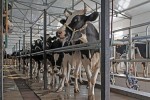 From Dr. Annette Jones, D.V.M., State Veterinarian and Director
From Dr. Annette Jones, D.V.M., State Veterinarian and Director
The California Department of Food and Agriculture (CDFA) has cooperated with the livestock industry and the U.S. Department of Agriculture’s (USDA) Animal and Plant Health Inspection Service (APHIS) since 1934 to eradicate brucellosis. California obtained brucellosis-free status in 1997. By 2007, the national eradication program had achieved an all-time low national herd prevalence of less than 0.0001 percent and since July 2009 the USDA has designated all fifty states as Class Free for bovine brucellosis. Despite recent detections of infection in livestock in the Greater Yellowstone Area (GYA) states of Idaho, Montana and Wyoming, where the disease is endemic in wild elk and bison, all three states remain Class Free. The national surveillance plan changed in 2009 to direct resources to the challenges from brucellosis in wildlife and eliminated funding for the brucellosis milk ring test (BRT) program and for brucellosis testing at sale yards and reduced slaughter surveillance.
California maintained a BRT program through July 2014, testing milk samples from all commercial dairies twice a year. It has been over 22 years since the last dairy herd was detected with brucellosis in California using the BRT. Ensuring the collection of fresh milk samples representing every milking cow from every dairy has become difficult and costly due to California’s large dairies and complex marketing strategies, and it has been determined that CDFA’s resources could be better utilized in other activities.
As of August 1, 2014 we are ceasing the brucellosis milk surveillance program and will rely on slaughter surveillance, private tests, and the examination of aborted fetuses and samples from aborting cattle submitted to the laboratory to detect infection and meet the national surveillance goals to maintain brucellosis free status.









